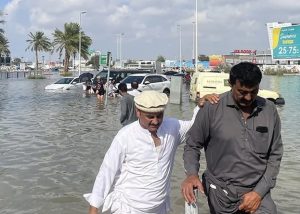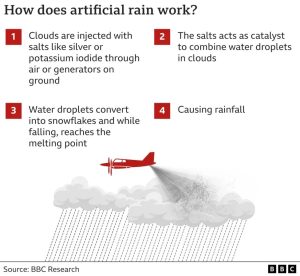Dubai’s major airlines, Emirates and flydubai, have resumed a full flight schedule after torrential rain hit the United Arab Emirates and neighboring countries, causing chaos at Dubai airport. While operations are back to normal, a passenger backlog remains. The boss of Emirates acknowledges that the airline’s response was not perfect.

The storm battered the UAE on Tuesday, leading to flash floods and disrupting travel through Dubai International Airport. A flooded taxiway prevented planes from reaching the runway for takeoff, leaving passengers stranded in the terminal building. Priority is being given to passengers whose travel plans were disrupted.
Emirates’ President, Sir Tim Clark, stated that passengers previously stranded in the airport transit area have been rebooked and are en route to their destinations. An open letter on the airlines’ website announced that regular flight schedules have been restored, but it will take some days to clear the backlog of rebooked passengers. A task force has been established to sort and deliver the approximately 30,000 pieces of luggage left behind .
Dubai experienced record floods over the past 24 hours, leading to speculation about cloud seeding. But how unusual was the rainfall, and what caused these extreme downpours?
Dubai typically has an arid climate, receiving less than 100mm (3.9 inches) of rainfall on average per year. However, occasional extreme downpours do occur. For instance, in the city of Al-Ain, just over 100km (62 miles) from Dubai, approximately 256mm (10 inches) of rain was recorded in a single day

Did Cloud Seeding Cause Heavy Rain ?
Cloud seeding is a fascinating weather modification technique. Its purpose is to alter the amount or type of precipitation, mitigate hail, or disperse fog. Here’s how it works:
The primary goal of cloud seeding is to either increase rain or snowfall or to prevent precipitation from occurring on specific days.
Process: Cloud seeding involves dispersing substances into the air that serve as cloud condensation or ice nuclei. These agents encourage the formation of ice particles or water droplets within clouds. Common substances used include:
Silver iodide,Potassium iodide,Dry ice (solid carbon dioxide),Hygroscopic materials like table salt, which can attract moisture and enhance cloud processes.
Planes fly over a region, releasing compounds like silver iodide into clouds, causing condensation and precipitation.
Drones can deliver electric charges to stimulate rainfall, and infrared laser pulses can induce particle formation.
So, when Dubai experienced record floods recently, some speculated about cloud seeding. While the rainfall was unusual for the region, it’s essential to understand that cloud seeding is a deliberate process, not the cause of natural weather events.

In a statement issued t, the NCM, which oversees cloud-seeding operations in the UAE, said there were no such cloud-seeding operations before or during the storm.
what really happened in Dubai is still not known.







